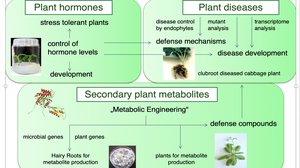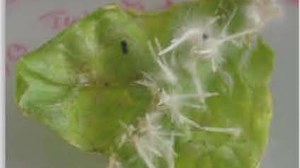Research Plant Physiology
Our research focuses on mechanisms leading to plant-pathogen (clubroot disease) interactions or the interaction with beneficial microorganisms (fungal endophytes). We are interested in the role of plant hormones and secondary plant products for development of pathogenic or symbiotic interactions of fungi with host plants. For better understanding of the events leading to pathogenesis, we have begun to identify differentially expressed genes during host/pathogen interaction and use biochemical and molecular methods to characterise the function of enzymes involved. We are also interested in the role of plant hormones during plant development and abiotic stress and therefore study biosynthesis, metabolism and regulation mechanisms controlling the endogenous concentrations of these compounds.
 © JLM
© JLM
Research Plant Physiology
PLASMODIOPHORA - CLUBROOT DISEASE
The clubroot disease of the Brassicaceae is probably worldwide the most damaging plant disease within this family. The obligate biotrophic pathogen Plasmodiophora brassicae can infect all Brassica species as well as the model plant Arabidopsis thaliana. As an obligate biotroph, P. brassicae complete its life cycle within the host roots. Only the resting spores of the pathogen can be detected outside the plant tissue. The disease is difficult to control by either chemical or cultural means. Therefore, it is of great importance to understand the development of the clubroot disease and to design methods for clubroot control. Since the first sequence of a reference genome (article) research is now concentrating also on the protist itself.
- Ludwig-Müller, J. (2022) What can we learn from -omics approaches to understand clubroot disease? Int. J. Mol. Sci.23: 6293 article
- Auer, S., Ludwig-Müller, J. (2023) Biocontrol of clubroot disease: how successful are endophytic fungi and bacteria? Eur. J. Plant Pathol. article
- Adhikary, D., Chapara, V., Islam, A., Truman, W., Ludwig-Müller, J. (2025) Clubroot Disease: 145 Years Post-Discovery, Challenges and Opportunities. Annu. Rev. Phytopathol. 63: 603-626 article
- Susann Auer about the clubroot disease (in German) youtube MDR Garten
- Lecture on the clubroot disease and biocontrol by Susann Auer (in English) Molecular response of clubroot infected plants to the endophytic fungus Acremonium alternatum
Special issues in journals on the topic
PLANT HORMONES
Plant hormones are important substances for growth and development of plants. We are mainly interested in the role of auxins for plant developmental processes and under stress situations such as heat or drought stress. Auxins are a class of plant hormones that control in low amounts a plethora of developmental processes, but inhibit plant growth at higher concentrations. Therefore, the regulation of hormone concentration is crucial for proper development of plants.
- Ludwig-Müller, J. (2011) Auxin conjugates: their role for plant development and in the evolution of land plants. J. Exp. Bot. 62: 1757-1773 article
BIOACTIVE SUBSTANCES
Plants are not only sources for nutrition, but also supply plenty of compounds of importance for medicinal and pharmaceutical uses. In the continued efforts to identify new substances with useful biological properties plants remain a major source. In addition, endophytic fungi, togehter with plants or alone, are valuable sources for the identification of novel, bioactive metabolites. We are interested in the analysis of such compounds.
- Ludwig-Müller, J., Jahn, J., Lippert, A., Püschel, J., Walter, A. (2014) Improvement of hairy root cultures and plants by changing biosynthetic pathways leading to pharmaceutical metabolites: strategies and applications. Biotechnol. Adv. 32: 1168-1179 Artikel
Read more: Research projects





